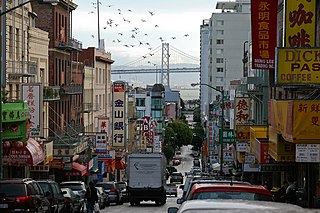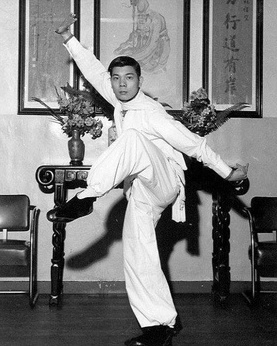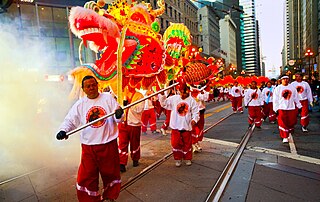Related Research Articles

The Chinatown centered on Grant Avenue and Stockton Street in San Francisco, California, is the oldest Chinatown in North America and one of the largest Chinese enclaves outside Asia. It is also the oldest and largest of the four notable Chinese enclaves within San Francisco. Since its establishment in the early 1850s, it has been important and influential in the history and culture of ethnic Chinese immigrants in North America. Chinatown is an enclave that has retained its own customs, languages, places of worship, social clubs, and identity.

A diorama is a replica of a scene, typically a three-dimensional model either full-sized or miniature. Sometimes it is enclosed in a glass showcase for a museum. Dioramas are often built by hobbyists as part of related hobbies such as military vehicle modeling, miniature figure modeling, or aircraft modeling.

The Chinatown neighborhood in Oakland, California, is traditionally Chinese which reflects Oakland's diverse Chinese American, and more broadly Asian American community. It is frequently referred to as "Oakland Chinatown" in order to distinguish it from nearby San Francisco's Chinatown. It lies at an elevation of 39 feet.

Tyrus Wong was a Chinese-born American artist. He was a painter, animator, calligrapher, muralist, ceramicist, lithographer and kite maker, as well as a set designer and storyboard artist. One of the most-influential and celebrated Asian-American artists of the 20th century, Wong was also a film production illustrator, who worked for Disney and Warner Bros. He was a muralist for the Works Progress Administration (WPA), as well as a greeting card artist for Hallmark Cards. Most notably, he was the lead production illustrator on Disney's 1942 film Bambi, taking inspiration from Song dynasty art. He also served in the art department of many films, either as a set designer or storyboard artist, such as Rebel Without a Cause (1955), Around the World in 80 Days (1956), Rio Bravo (1959), The Music Man (1962), PT 109 (1963), The Great Race (1965), Harper (1966), The Green Berets (1968), and The Wild Bunch (1969), among others.

Frank Chin is an American author and playwright. He is considered to be one of the pioneers of Asian-American theatre.

Wah Ching is a Chinese American criminal organization and street gang that was founded in San Francisco, California in 1964. The Wah Ching has been involved in crimes including narcotic sales, racketeering, and gambling.

Wong Jack-man was a Chinese martial artist and teacher. He was best known for his controversial duel with Bruce Lee in 1964.

The San Francisco Chinese New Year Festival and Parade is an annual event in San Francisco, California, United States. Held for approximately two weeks following the first day of the Chinese New Year, it combines elements of the Chinese Lantern Festival with a typical American parade. First held in 1851, along what are today Grant Avenue and Kearny Street, it is the oldest and one of the largest events of its kind outside of Asia, and one of the largest Asian cultural events in North America. The parade route begins on Market Street and terminates in Chinatown.

The Miss Chinatown USA pageant, based on Chinese communities within the U.S., greets delegates around the country. The pageant has been an annual Lunar New Year event since 1958. The winners of this pageant represent the Chinese community and act as ambassadors promoting Chinese culture and heritage.

Forbidden City was a Chinese nightclub and cabaret in San Francisco, which was in business from 1938 to 1970, and operated on the second floor of 363 Sutter Street, between Chinatown and Union Square.
Martin Wong was a Chinese-American painter of the late 20th century. His work has been described as a meticulous blend of social realism and visionary art styles. Wong's paintings often explored multiple ethnic and racial identities, exhibited cross-cultural elements, demonstrated multilingualism, and celebrated his queer sexuality.
Him Mark Lai was a historian of Chinese American, a leader of the Chinese-American community, and writer. He helped restore the state of Chinese American historiography. Lai "rescued, collected, catalogued, preserved and shared" historical sources in Chinese and English. He was known as the "Dean of Chinese American history" by his academic peers, despite the fact that he was professionally trained as a mechanical engineer with no advanced training in the academic field of history. The Chronicle of Higher Education named Lai "the scholar who legitimized the study of Chinese America".

The Chinese Historical Society of America is the oldest and largest archive and history center documenting the Chinese American experience in the United States. It is based in the Chinatown neighborhood of San Francisco, California.

Chinatowns are enclaves of Chinese people outside of China. The first Chinatown in the United States was San Francisco's Chinatown in 1848, and many other Chinatowns were established in the 19th century by the Chinese diaspora on the West Coast. By 1875, Chinatowns had emerged in eastern cities such as New York City, Boston, and Philadelphia. The Chinese Exclusion Act of 1882 barred Chinese immigration to the United States, but the Magnuson Act of 1943 repealed it, and the population of Chinatowns began to rise again.

The San Francisco riot of 1877 was a three-day pogrom waged against Chinese immigrants in San Francisco, California by the city's majority Irish population from the evening of July 23 through the night of July 25, 1877. The ethnic violence which swept Chinatown resulted in four deaths and the destruction of more than $100,000 worth of property belonging to the city's Chinese immigrant population.
One Hundred Years: History of the Chinese in America is a 1952 mural painting by James Leong.
Philip P. Choy was an architect and historian of Chinese American studies. He is the author of San Francisco Chinatown: A Guide to Its History & Architecture (2012), Canton Footprints: Sacramento’s Chinese Legacy (2007), and The Coming Man: 19th Century American Perceptions of the Chinese (1994). Choy has been a community activist known for landmark preservation in San Francisco.

Johnny Kan (1906–1972) was a Chinese American restaurateur in Chinatown, San Francisco, ca 1950–1970. He was the owner of Johnny Kan's restaurant, which opened in 1953, and published a book on Cantonese cuisine, Eight Immortal Flavors, which was praised by Craig Claiborne and James Beard. Kan and Cecilia Chiang are credited with popularizing authentic Chinese cuisine as a fine dining option, displacing the stereotypical chop suey American Chinese cuisine prevalent in the 1950s and 60s.
As of 2012, 21.4% of the population in San Francisco was of Chinese descent, and there were at least 150,000 Chinese American residents. The Chinese are the largest Asian American subgroup in San Francisco. San Francisco has the highest percentage of residents of Chinese descent of any major U.S. city, and the second largest Chinese American population, after New York City. The San Francisco Area is 7.9% Chinese American, with many residents in Oakland and Santa Clara County. San Francisco's Chinese community has ancestry mainly from Guangdong province, China and Hong Kong, although there is a sizable population of ethnic Chinese with ancestry from other parts of mainland China and Taiwan as well.

Ping Yuen and North Ping Yuen form a four-building public housing complex in the north end of Chinatown, San Francisco along Pacific Avenue. In total, there are 434 apartments. The three Pings on the south side of Pacific were dedicated in 1951, and the North Ping Yuen building followed a decade later in 1961. Some of the largest murals in Chinatown are painted on Ping Yuen, which are prominent landmark buildings taller than the typical two- or three-story Chinatown buildings that date back to the early 1900s.
References
- 1 2 3 4 5 6 7 8 9 10 Guthrie, Julian (23 August 2014). "Frank Wong recalls life in Chinatown through miniature dioramas". San Francisco Chronicle. Retrieved 26 August 2014.
- 1 2 3 4 "Chinatown Miniatures Collection". Chinese Historical Society of America. 8 March 2007. Archived from the original on 29 January 2015. Retrieved 26 August 2014.
- ↑ ""Chinatown in Miniature" Presentation by Artist Frank Wong". Chinese Historical Society of America. 18 February 2011. Retrieved 26 August 2014.
- ↑ "Home". foreverchinatown.com.
- ↑ "Frank Wong and His Chinatown Miniatures". IMDB.com. Retrieved 26 August 2014.
- ↑ "Frank Wong's Chinatown". Good Medicine Picture Company. Archived from the original on 27 August 2014. Retrieved 26 August 2014.
- 1 2 Koeppel, Geri (March 2016). "Local Filmmaker Translates Miniature Chinatown Scenes To The Big Screen". Hoodline. Retrieved 16 February 2017.
- ↑ "Frank Wong's Chinatown (working title)". CAMMFest. Retrieved 16 February 2017.
- ↑ "Forever, Chinatown | Kanopy".